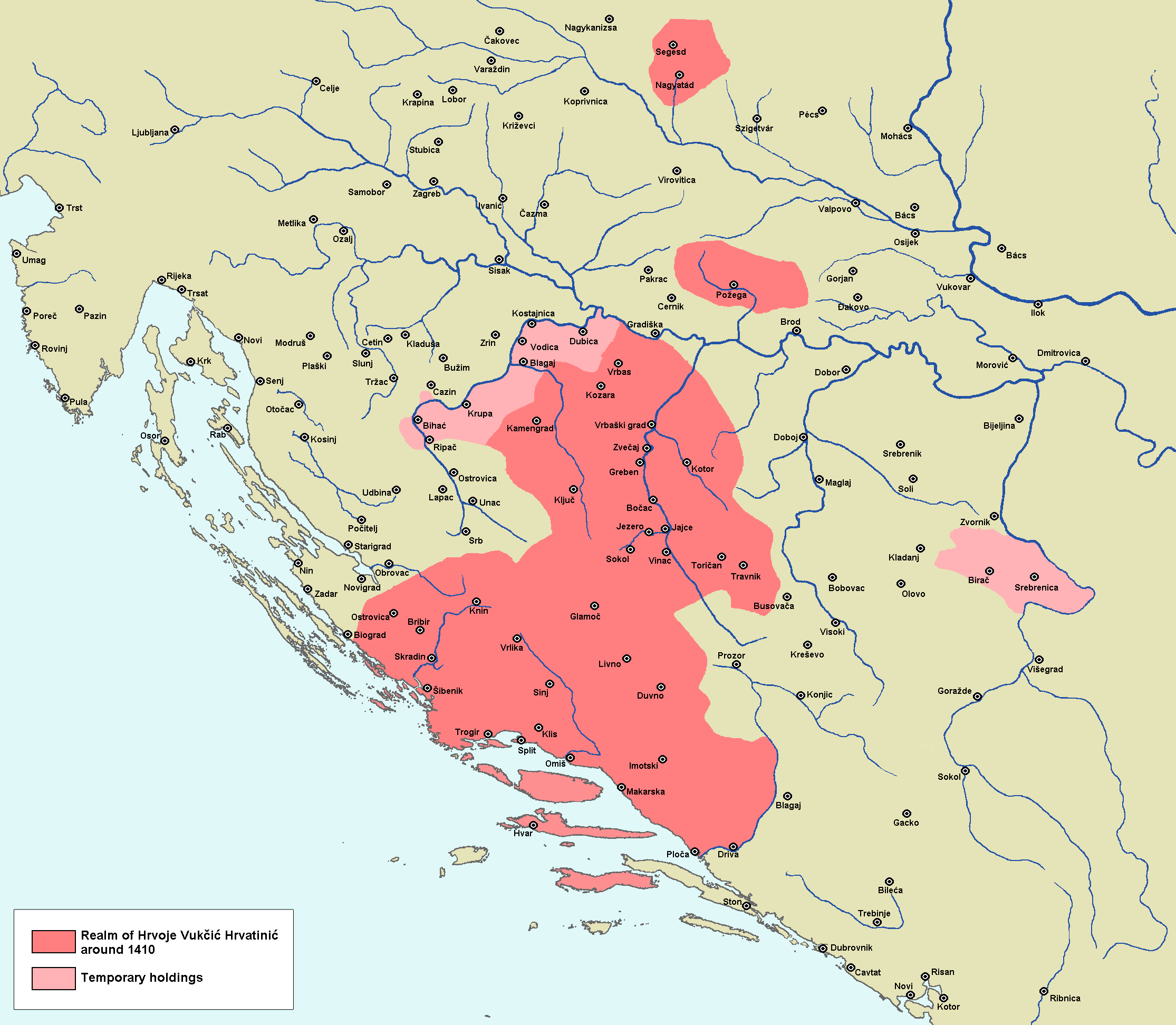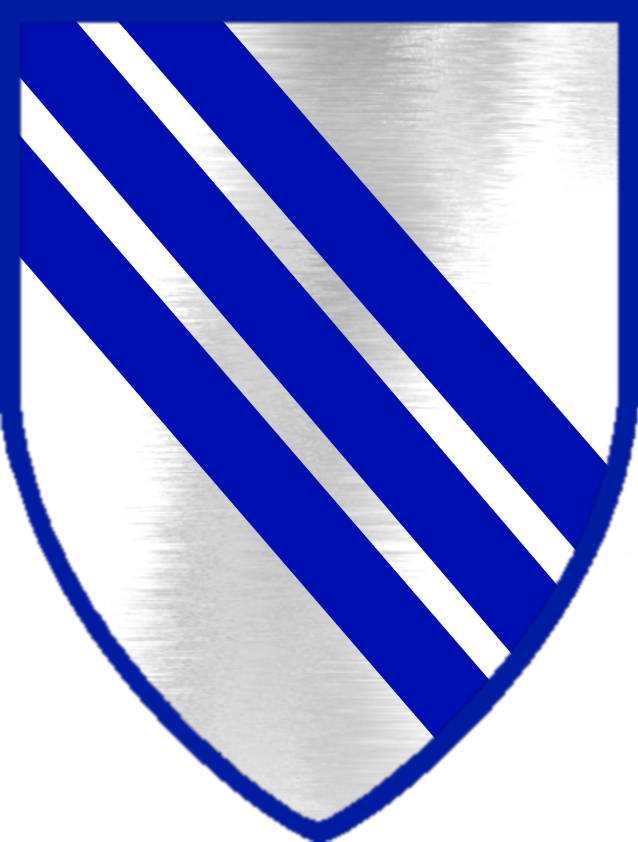|
Katarina Vuković
Katarina Vuković is from the medieval Bosnian noble lineage Hrvatinić, the second wife of Grand Duke of Bosnia, Sandalj Hranić. Katarina was the daughter of the Hungarian-Croatian ban Vuk Vukčić from the Bosnian noble family of Hrvatinić. Her uncle was the famous Bosnian Grand Duke Hrvoje Vukčić Hrvatinić. Her mother was Banness Anka, and her sister was Jelena, married to Sandalj's brother, Knyaz Vuk Hranić. Katarina married Sandalj Hranić in the spring of 1405, when her sister Jelena married Sandalj's brother Knyaz Vuk Hranić. Katarina's marriage to Sandalj existed as a result of political ties between Hrvatinić and Kosača noble families. Katarina, her mother Anka, and Duke Sandalj Hranić kept their property in a deposit in Dubrovnik Dubrovnik (), historically known as Ragusa (; see notes on naming), is a city on the Adriatic Sea in the region of Dalmatia, in the southeastern semi-exclave of Croatia. It is one of the most prominent tourist destinatio ... [...More Info...] [...Related Items...] OR: [Wikipedia] [Google] [Baidu] |
Bosnia And Herzegovina In The Middle Ages
This is the history of Bosnia and Herzegovina in the Middle Ages, between the ancient and Roman period and the Ottoman period. Early Middle Ages The western Balkans had been reconquered from "barbarians" by Byzantine Emperor Justinian (r. 527–565). Sclaveni (Slavs) raided the Western Balkans, including Bosnia, in the 6th and 7th century. According to ''De Administrando Imperio'' written in 10th century, these were followed by Croats and Serbs who arrived in the late 620s and early 630s, the Croats invited by Emperor Heraclius to fend off an invasion by the Pannonian Avars, and both had by this time settled West and East of Bosnia. Croats "settled in area roughly corresponding to modern Croatia, and probably also including most of Bosnia proper, apart from the eastern strip of the Drina valley" while Serbs "corresponding to modern south-western Serbia (later known as Raška), and gradually extended their rule into the territories of Duklja and Hum". Early medieval polity ... [...More Info...] [...Related Items...] OR: [Wikipedia] [Google] [Baidu] |
Hrvatinić
House of Hrvatinić was a Bosnian medieval noble family that emerged in Donji Kraji county, located in today's territory of western Bosnia and Herzegovina. Principally they were vassals to Kotromanić dynasty of the Banate of Bosnia and Kingdom of Bosnia, occasionally also to the Kingdom of Hungary, changing loyalties between Hungarian kings Ladislaus of Naples and Sigismund of Luxembourg, and finally the Ottoman Empire (1472–1476). They rose to prominence in the second half of the 14th century, and attained its peak under magnate Hrvoje Vukčić Hrvatinić (1350–1416), who also held large swaths of Dalmatia and obtained title of Grand Duke of Bosnia in 1380. Its eponymous founder was Hrvatin Stjepanić ( 1299–1304), a count and holder of possession in parts of "Donji Kraji" ( en, Lower Ends) and "Zapadne Strane" ( en, "Western Sides"), and a vassal of Croatian magnate Paul I Šubić of Bribir. Hrvatin's sons was part of a coalition of Bosnian and Slavonian nobility that re ... [...More Info...] [...Related Items...] OR: [Wikipedia] [Google] [Baidu] |
Grand Duke Of Bosnia
Grand Duke of Bosnia ( sh, veliki vojvoda rusaga bosanskog, la, Bosne supremus voivoda / Sicut supremus voivoda regni Bosniae), was a court title in the Kingdom of Bosnia, bestowed by the monarch to highest military commanders, usually reserved for most influential and most capable among highest Bosnian nobility. To interpret it as an office post rather than a court rank could be more accurate, although it was not hereditary it served both purposes and was retained for life by a noblemen who gained it. History Unlike usage in Western Europe or Central Europe, as well as in various Slavic lands from Central to North-East Europe, where analogy between grand duke and grand prince was significant, with both titles corresponding to sovereign lower than king but higher than duke, in Bosnia the title of grand duke corresponded more to the Byzantine military title '' megas doux''. Generally, Slavic word ''knez'' is often referred to ruler, sometimes analogous to king, thus ''veliki kn ... [...More Info...] [...Related Items...] OR: [Wikipedia] [Google] [Baidu] |
Sandalj Hranić
Sandalj Hranić Kosača ( cyrl, Сандаљ Хранић Косача; 1370 – 15 March 1435) was the most powerful Bosnian nobleman whose primary possessions consisted of land areas between Adriatic coast, the Neretva and the Drina rivers in Bosnia, and served the court as the ''Grand Duke of Bosnia'' sometime between 1392 and his death in 1435, although the first mention as a Grand Duke in sources comes from 16 June 1404. He was married three times, but had no children. After his death, he was succeeded by his nephew Stjepan Vukčić Kosača. Rise of Sandalj As the head of the House of Kosača, Sandalj Hranić succeeded his uncle Vlatko Vuković in 1392. In 1403, Radič Sanković led the attacks on Dubrovnik during the Bosnian-Ragusan War in the name of King Stephen Ostoja. Sandalj Hranić captured and blinded Radič, and held him in prison until his death in 1404. When King Ladislaus of Naples sold his rights to the kingdom of Dalmatia to the Republic of Venice ... [...More Info...] [...Related Items...] OR: [Wikipedia] [Google] [Baidu] |
Bosnian Grand Duke
Grand Duke of Bosnia ( sh, veliki vojvoda rusaga bosanskog, la, Bosne supremus voivoda / Sicut supremus voivoda regni Bosniae), was a court title in the Kingdom of Bosnia, bestowed by the monarch to highest military commanders, usually reserved for most influential and most capable among highest Bosnian nobility. To interpret it as an office post rather than a court rank could be more accurate, although it was not hereditary it served both purposes and was retained for life by a noblemen who gained it. History Unlike usage in Western Europe or Central Europe, as well as in various Slavic lands from Central to North-East Europe, where analogy between grand duke and grand prince was significant, with both titles corresponding to sovereign lower than king but higher than duke, in Bosnia the title of grand duke corresponded more to the Byzantine military title '' megas doux''. Generally, Slavic word ''knez'' is often referred to ruler, sometimes analogous to king, thus ''veliki kn ... [...More Info...] [...Related Items...] OR: [Wikipedia] [Google] [Baidu] |
Hrvoje Vukčić Hrvatinić
Hrvoje Vukčić Hrvatinić (ca. 1350–1416) was a medieval Bosnian nobleman and magnate, Grand Duke of Bosnia, Knyaz of Donji Kraji, and Duke of Split. He was the most prominent member of the Hrvatinić noble family, and one of the major feudal lords in Kingdom of Bosnia. He was Grand Duke of Bosnia under three Bosnian kings: King Tvrtko I, King Stephen Dabiša and King Stephen Ostoja. In 1403 Ladislaus of Naples named him his deputy for Dalmatia, and bestowed him with a title ''Duke of Split'', later ''Herzog of Split''. He played a crucial role in the dynastic struggles between the Anjou and Luxembourg claimants to the Hungarian-Croatian throne at the end of the 14th century, as well as in the emergence of the Bosnian Kingdom as a regional power during the same period. Family Connections Hrvoje was the eldest son of Duke Vukac Hrvatinić. He had three brothers: Vuk (who was Ban of Croatia), Dragiša and Vojislav. He was married to Jelena Nelipčić,Sveučilište u Zagr ... [...More Info...] [...Related Items...] OR: [Wikipedia] [Google] [Baidu] |
Ban (title)
Ban () was a noble title used in several states in Central and Southeastern Europe between the 7th century and the 20th century. The most common examples have been found in Croatia. Sources The first known mention of the title ''ban'' is in the 10th century by Constantine VII Porphyrogenitus, in the work '' De Administrando Imperio'', in the 30th and 31st chapter "Story of the province of Dalmatia" and "Of the Croats and of the country they now dwell in", dedicated to the Croats and the Croatian organisation of their medieval state. In the 30th chapter, describing in Byzantine Greek, how the Croatian state was divided into eleven (; župas), the ban (), (rules over) (Krbava), ( Lika) (and) (Gacka). In the 31st chapter, describing the military and naval force of Croatia, " Miroslav, who ruled for four years, was killed by the () (, i.e. Pribina)", and after that followed a temporary decrease in the military force of the Croatian Kingdom. In 1029, a Latin charter was publ ... [...More Info...] [...Related Items...] OR: [Wikipedia] [Google] [Baidu] |
Knyaz
, or ( Old Church Slavonic: Кнѧзь) is a historical Slavic title, used both as a royal and noble title in different times of history and different ancient Slavic lands. It is usually translated into English as prince or duke, depending on specific historical context and the potentially known Latin equivalents of the title for each bearer of the name. In Latin sources the title is usually translated as , but the word was originally derived from the common Germanic (king). The female form transliterated from Bulgarian and Russian is (), in Slovene and Serbo-Croatian (Serbian Cyrillic: ), ''kniahinia'' (княгіня) in Belarusian and ''kniazioŭna'' (князёўна) is the daughter of the prince, (княгиня) in Ukrainian. In Russian, the daughter of a knyaz is (). In Russian, the son of a knyaz is ( in its old form). The title is pronounced and written similarly in different European languages. In Serbo-Croatian and some West Slavic languages, the word ... [...More Info...] [...Related Items...] OR: [Wikipedia] [Google] [Baidu] |
Republic Of Ragusa
hr, Sloboda se ne prodaje za sve zlato svijeta it, La libertà non si vende nemmeno per tutto l'oro del mondo"Liberty is not sold for all the gold in the world" , population_estimate = 90 000 in the XVI Century , currency = Ragusa perpera and others , common_languages = , title_leader = Rector as Head of state , leader1 = Nikša Sorgo , year_leader1 = 1358 , leader2 = Sabo Giorgi , year_leader2 = 1807-1808 , today = Croatia Bosnia and Herzegovina Montenegro , footnotes = A Romance language similar to both Italian and Romanian. While present in the region even before the establishment of the Republic, Croatian, also referred to as ''Slavic'' or ''Illyrian'' at the time, had not become widely spoken until late 15th century. The Republic of Ragusa ( dlm, Republica de Ragusa; la, Respublica Ragusina; it, Repubblica di Ragusa; hr, Dubrovačka Republika ... [...More Info...] [...Related Items...] OR: [Wikipedia] [Google] [Baidu] |
Hrvatinić Noble Family
House of Hrvatinić was a Bosnian medieval noble family that emerged in Donji Kraji county, located in today's territory of western Bosnia and Herzegovina. Principally they were vassals to Kotromanić dynasty of the Banate of Bosnia and Kingdom of Bosnia, occasionally also to the Kingdom of Hungary, changing loyalties between Hungarian kings Ladislaus of Naples and Sigismund of Luxembourg, and finally the Ottoman Empire (1472–1476). They rose to prominence in the second half of the 14th century, and attained its peak under magnate Hrvoje Vukčić Hrvatinić (1350–1416), who also held large swaths of Dalmatia and obtained title of Grand Duke of Bosnia in 1380. Its eponymous founder was Hrvatin Stjepanić ( 1299–1304), a count and holder of possession in parts of "Donji Kraji" ( en, Lower Ends) and "Zapadne Strane" ( en, "Western Sides"), and a vassal of Croatian magnate Paul I Šubić of Bribir. Hrvatin's sons was part of a coalition of Bosnian and Slavonian nobility ... [...More Info...] [...Related Items...] OR: [Wikipedia] [Google] [Baidu] |


.jpg)

.jpg)